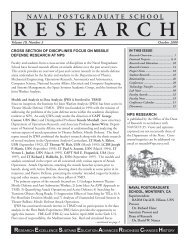Spectral Unmixing Applied to Desert Soils for the - Naval ...
Spectral Unmixing Applied to Desert Soils for the - Naval ...
Spectral Unmixing Applied to Desert Soils for the - Naval ...
Create successful ePaper yourself
Turn your PDF publications into a flip-book with our unique Google optimized e-Paper software.
A spectral library was <strong>the</strong>n built and <strong>the</strong> spectra <strong>for</strong> <strong>the</strong> various levels of disturbance were<br />
used as inputs <strong>for</strong> <strong>the</strong> mixture analysis and mapping of <strong>the</strong> AVIRIS imagery.<br />
Figure 19. This figure illustrates <strong>the</strong> original sample radiance data (red) and white<br />
reference spectrum (black) collected with <strong>the</strong> ASD spectrometer (left)<br />
compared <strong>to</strong> <strong>the</strong> spectrum calculated using spectral math (right). The blue<br />
reflectance spectrum (right), represents <strong>the</strong> red spectrum (left) divided by<br />
<strong>the</strong> black spectrum (left) (solar spectrum removed).<br />
3. <strong>Spectral</strong> Mixture Analysis<br />
The mixture-tuned matched filter (MTMF) approach was used in this research.<br />
The MTMF process combines older methods of Matched Filtering (MF), used <strong>for</strong> target<br />
signal detection and signal processing, with newer methods and algorithms that account<br />
<strong>for</strong> mixing of reflectance that occurs within a pixel (Figure 20) (Boardman and Kruse,<br />
2011). The previous MF method had a high false alarm rate and exhibited difficulty<br />
distinguishing between similar yet rare targets in <strong>the</strong> image space because of mixing that<br />
40
















